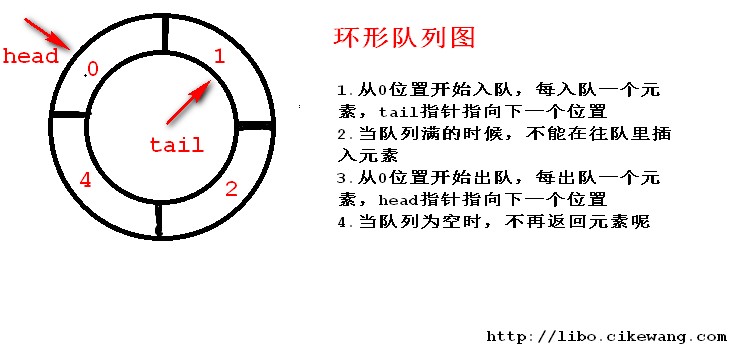数据结构之队列
先进先出 FIFO : first in first out
队列形式分:普通队列、环形队列
队列用途:自动排号机
环形队列实现

/*
* MyQueue.h
* Author: libo
*/
#ifndef MYQUEUE_H_
#define MYQUEUE_H_
class MyQueue {
public:
// C++
MyQueue(int queueCapacity); // 创建队列
virtual ~MyQueue(); // 销毁队列
void ClearQueue(); // 清空队列
bool QueueEmpty() const; // 判断是否为空队列
bool QueueFull() const; // 判断队列是否满了
int QueueLength() const; // 队列长度
bool EnQueue(int element); // 新元素入队
bool DeQueue(int &element); // 首元素出队
void QueueTraverse(); // 遍历队列
private:
int *m_pQueue; // 队列数组指针
int m_iQueueLen; // 队列元素个数
int m_iQueueCapacity; // 队列数组容量
int m_iHead; // 队头
int m_iTail; // 队尾
};
#endif /* MYQUEUE_H_ */
/*
* MyQueue.cpp
* Author: libo
*/
#include <iostream>
#include "MyQueue.h"
using namespace std;
MyQueue::MyQueue(int queueCapacity) {
m_iQueueCapacity = queueCapacity;
m_iHead = 0;
m_iTail = 0;
m_iQueueLen = 0;
m_pQueue = new int[queueCapacity]; // 从堆中申请内存,初始化队列大小
}
MyQueue::~MyQueue() {
delete []m_pQueue;
m_pQueue = NULL;
}
// 清空队列
void MyQueue::ClearQueue() {
m_iHead = 0;
m_iTail = 0;
m_iQueueLen = 0;
}
// 判断当前队列是否为空
bool MyQueue::QueueEmpty() const {
if (m_iQueueLen == 0) {
return true;
}
return false;
}
// 队列长度
int MyQueue::QueueLength() const {
return m_iQueueLen;
}
// 判断队列是否满了
bool MyQueue::QueueFull() const {
if (m_iQueueLen == m_iQueueCapacity) {
return true;
}
return false;
}
// 新元素入队
bool MyQueue::EnQueue(int element) {
// 判断队里是否满了
if (QueueFull()) {
return false;
}
// 将新元素添加到队尾
m_pQueue[m_iTail] = element;
m_iTail++; // 队尾指针向后移动
m_iTail = m_iTail % m_iQueueCapacity;
m_iQueueLen++;
return true;
}
// 首元素出队
bool MyQueue::DeQueue(int &element) {
// 判断队列是否为空
if (QueueEmpty()) {
return false;
}
element = m_pQueue[m_iHead];
m_iHead++;
m_iHead = m_iHead % m_iQueueCapacity;
m_iQueueLen--;
return true;
}
// 遍历队列
void MyQueue::QueueTraverse() {
for (int i = m_iHead; i < m_iQueueLen + m_iHead; i++) {
cout << m_pQueue[i%m_iQueueCapacity] << endl;
}
}
#include <iostream>
#include <stdlib.h>
#include "MyQueue.h"
using namespace std;
int main(void) {
MyQueue *p = new MyQueue(4);
p->EnQueue(10);
p->EnQueue(12);
p->EnQueue(16);
p->EnQueue(18);
p->EnQueue(20);
p->QueueTraverse();
int e = 0;
p->DeQueue(e);
cout << endl;
cout << e << endl; p->DeQueue(e);
cout << endl;
cout << e << endl;
cout << endl; p->QueueTraverse();
cout << endl; p->ClearQueue();
cout << endl; p->EnQueue(20);
p->EnQueue(30);
p->QueueTraverse();
cout << endl;
delete p;
p = NULL;
return 0;
}
代码:https://github.com/cikewang/DataStructur/tree/master/MyQueue